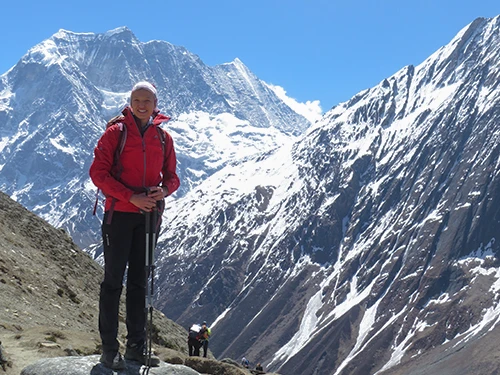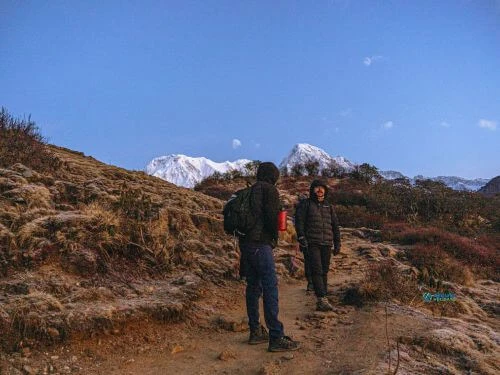Langtang Valley Trek Difficulty
We rate this trek as moderate, suitable for most people with basic fitness. You’ll encounter:
- Well-maintained trails with some steep and uneven sections
- Daily walking times between 5 to 7 hours at a steady pace
- Altitudes that require proper acclimatization, which is built into the itinerary
Our experienced guides will support you throughout, helping you manage the physical demands and enjoy every moment.
How Fit Should You Be for the Langtang Valley Trek?
We rate this trek as moderate — a rewarding journey suitable for most people with basic fitness. Here’s what to expect:
- Well-maintained trails with some steep and uneven sections
- Daily walking times between 5 to 7 hours at a comfortable pace
- Gradual altitude gain that supports natural adjustment to elevation
While the route itself is designed to support a safe climb, acclimatization during the Langtang Valley Trek goes beyond just itinerary pacing. Staying hydrated, getting enough rest, and listening to your body are just as important. Our guides are trained to monitor your health and help you adapt comfortably at higher altitudes.
Recommednation Read:
How to Prepare for High Altitude Trek?
Langtang Valley Trek Permits and Entry Requirements
Before you can lace up your boots and hit the Langtang trails, there are a couple of important permits you’ll need — but don’t worry, Abound Holidays takes care of all of it for you.
You’ll need two main permits:
TIMS Card (Trekkers’ Information Management System): This costs around USD 20 and is used to register your trekker details for safety tracking. It helps authorities locate trekkers in case of emergencies, which is especially important in remote areas like Langtang.
Langtang National Park Entry Permit: Around USD 30, this fee helps protect the fragile ecosystem and supports conservation work across the region.
If your trek starts from areas like Sundarijal, a Shivapuri–Nagarjun National Park permit might also be required — but we’ll check your route and sort that out if needed.
To issue the permits, we just need a copy of your passport and two passport-sized photos. From there, we handle everything before your trek even begins. No standing in lines, no confusing paperwork — just peace of mind so you can focus on the mountains, not the logistics.
Best Time for the Langtang Valley Trek
The best time for Langtang Valley Trek would be spring and autumn season as they offer the most beautiful views and coloful nature at the time. Still you can visit on other season based on your preference.
Spring (March – May) – Highly Recommended
Langtang Valley in spring feels majestic as the valley bursts into color and life, and the weather gets pleasant. The trails are buzzing with wildlife, making it a fantastic time for both nature lovers and photographers. You can expect the best photography spots during this season.
Autumn (September – November) – Most Recommended
Autumn offers the clearest skies and the best mountain views you could ask for. The cool, dry weather means comfortable trekking, and the whole valley feels alive with energy and activity. At this time, you can enjoy:
- Clear skies and cool, dry weather
- Ideal mountain views and trail conditions
- Peak trekking season with great energy
Winter (December – February) – Recommended for Experienced Trekkers
If you’re looking for quiet trails and a peaceful, snowy landscape, winter is your chance to experience Langtang in a different light. Just be prepared for colder temperatures and possible route closures. Here’s what to expect:
- Quiet trails and peaceful surroundings
- Very cold nights and snow at higher altitudes
- Some routes may be blocked
Monsoon (June – August) – Not Recommended
Monsoon season brings heavy rain and slippery trails, which can make trekking challenging and sometimes unsafe. So it’s best to avoid this time unless you’re prepared for a real adventure. You might face:
- Heavy rainfall and slippery trails
- Poor visibility due to clouds and mist
- Risk of landslides and leeches in the lower forests
How to Prepare For the Langtang Valley Trek?
Being fit is important for the Langtang Valley Trek, but getting ready for the trek means more than just being physically fit. Here's what we will be helping you with:
- Detailed gear lists tailored to the season and your personal needs
- Health and safety advice, including essential tips on the langtang trek to prevent altitude sickness
- Information on travel insurance and visa requirements
- Ongoing support — our team will be available to answer your questions anytime before your trek
By preparing in these ways, you’ll be ready for a safe and enjoyable Langtang Valley adventure.
Packing List and Trekking Gear Essentials For Short ABC Trek
Packing for Langtang Valley Trek is all about finding the right balance between being prepared and keeping your backpack light. The Himalayas weather may change fast. Whether it be sunny afternoon, cold winter nights, windy evenings, and so layering is the main one. No matter when you go trekking, spring, autumn or even in winter, no matter the gear, you will make a world of a difference that will land you in comfortable and safe situations.
Here’s a breakdown of the essentials you’ll need:
Clothing – Layer Smart, Stay Comfortable
- Base layers (2–3 sets): These go directly against your skin and help wick away sweat. Choose moisture-wicking, breathable fabrics like merino wool or synthetic blends.
- Mid-layers (1–2 fleece or down jackets): Insulation layers that keep you warm. A fleece is perfect for daytime, and a lightweight down jacket is ideal for the cold mornings and evenings at higher elevations.
- Outer layer (1 waterproof jacket and pants): This is your defense against wind and rain. Make sure it’s breathable and fully waterproof—not just water-resistant.
- Trekking pants (2–3 pairs): Comfortable, quick-drying pants are best. Avoid jeans or heavy cotton.
- Thermal underwear (1–2 sets): Great for cold nights at higher elevations.
- T-shirts (3–4): Quick-dry shirts are ideal. Include at least one long-sleeved shirt for sun protection.
- Shorts (optional): Good for lower elevation days during spring or autumn.
- Sleepwear: Something warm and cozy for those chilly tea house nights.
Headwear & Accessories
- Warm hat/beanie: Essential for cold mornings and evenings.
- Sun hat or cap: To protect from harsh UV rays at altitude.
- Buff or scarf: Useful for wind, dust, and sun protection. A buff can double as a mask or neck warmer.
- Sunglasses (UV-protected): High-altitude sunlight can be intense—don’t skip these.
Gloves & Hand Protection
- Liner gloves: Lightweight and breathable for daytime.
- Insulated gloves: Necessary for higher altitudes where temperatures drop quickly.
Footwear & Foot Care
- Trekking boots (well broken-in): These are your most important piece of gear. Choose waterproof, ankle-supporting boots with good grip.
- Camp shoes (sandals or sneakers): For evenings around the tea house and letting your feet breathe.
- Trekking socks (3–4 pairs): Wool or synthetic socks that keep your feet dry and blister-free.
- Gaiters (optional): Helpful if you're trekking in snow or muddy conditions.
Bags & Packs
- Main backpack (50–65L): Comfortable, with a good waist strap and rain cover.
- Daypack (20–25L): If you’re using porters, you’ll need a smaller pack for essentials like water, snacks, and layers during the day.
- Dry bags or packing cubes: Keep your gear organized and safe from moisture.
Personal Hygiene & Toiletries
- Toilet paper and wet wipes: Not always provided at tea houses.
- Hand sanitizer: Essential for hygiene on the trail.
- Toothbrush, toothpaste, biodegradable soap, and travel towel.
- Sunscreen (SPF 30+): UV exposure is stronger at altitude.
- Lip balm with SPF: Dry air and sun can lead to chapped lips fast.
First Aid & Health Kit
- Basic first aid kit: Include band-aids, antiseptic cream, painkillers, and blister plasters.
- Personal medications: Don’t forget altitude tablets (consult your doctor), any prescription meds, or motion sickness tablets if you’re prone to it.
- Water purification tablets or filter: Though bottled water is available for purchase, it’s better to go sustainable and treat tap or stream water.
Trekking Essentials
- Trekking poles: Great for balance and reducing strain on your knees during ascents and descents.
- Headlamp (with extra batteries): Power outages happen, and some early starts require light.
- Reusable water bottles (1–2 liters): Stay hydrated throughout the trek.
- Energy bars/snacks: Trail mix, dried fruit, granola bars—great for quick fuel on the trail.
- Notebook or journal (optional): To capture reflections from your journey.
Optional but Helpful
- Sleeping bag (4-season): Most tea houses offer blankets, but in colder seasons or remote stops, a warm sleeping bag is a comfort.
- Power bank and charging cables: Electricity is limited and sometimes not available at higher altitudes.
- Travel insurance documents: In case of emergencies, you’ll want this handy.
Final Tips for Packing:
- Pack light: You will feel even an extra kilo weighing on you as the days pass. 10-12kg or less should be the goal when you carry yourself.
- Break in your boots beforehand: Never hit the trail in new shoes.
- Layering is key: The weather can change dramatically between morning, midday, and evening.
Packing well means you’re free to focus on the experience—the towering peaks, the kind-hearted locals, and the rhythm of your footsteps on the trail. If you’re not sure what to bring or prefer not to travel heavy, some gear is also available to rent or buy in kathmandu before the trek.
Book Langtang Valley Trek with Abound Holidays
Choosing the right trekking company makes all the difference. With Abound Holidays, we take care of all the tricky stuff like permits and logistics, so you can focus on enjoying the trek. Our local guides know the area and culture really well, and we keep groups small to give you a personal, meaningful experience.
We also believe in responsible travel that supports the local communities. Plus, you’ll have our team’s support anytime you need it be that maybe from booking to the end of your adventure. With Abound Holidays, your Langtang trek will be safe, fun, and something you’ll never forget. Contact us today to make your adventure come to life.
Want to take on a bigger challenge after Langtang? Then try our Manaslu Circuit Trek, which gives you stunning mountain views and a higher Himalayan adventure.
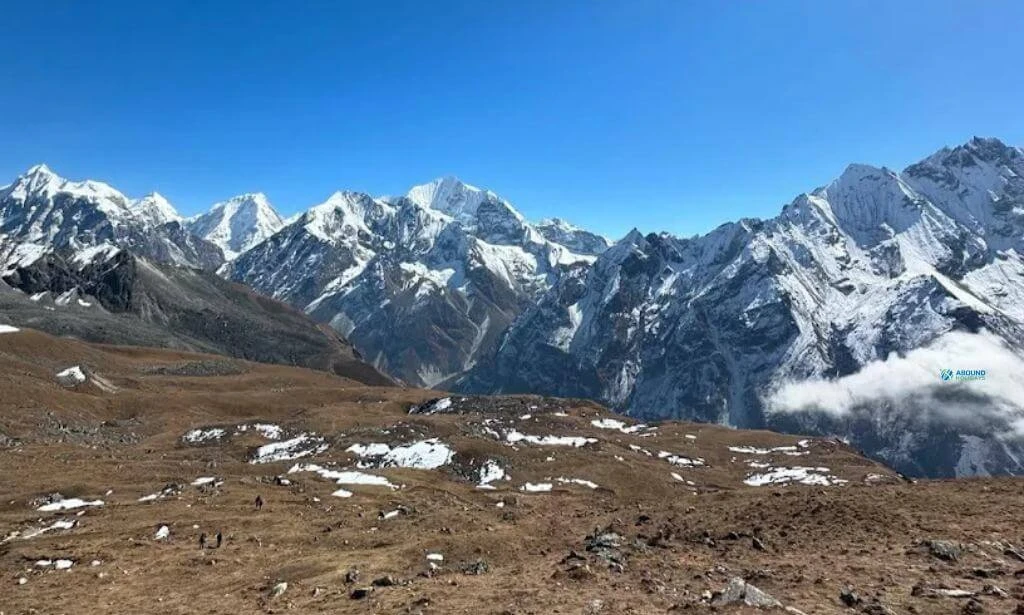
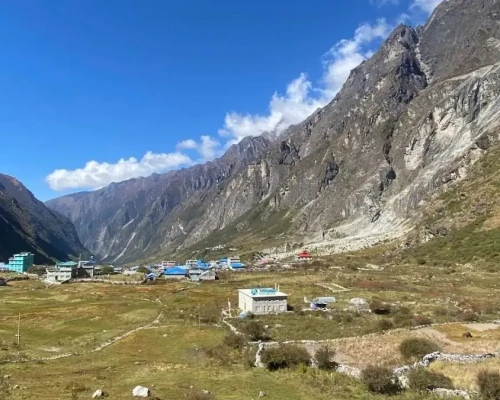
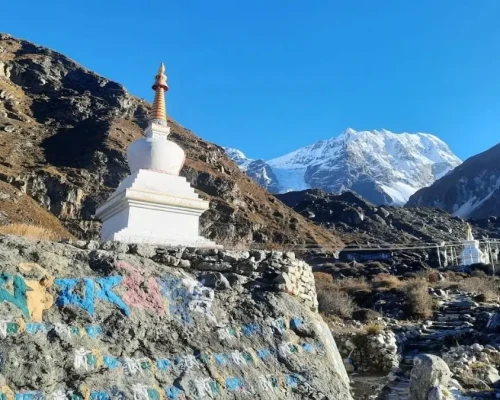
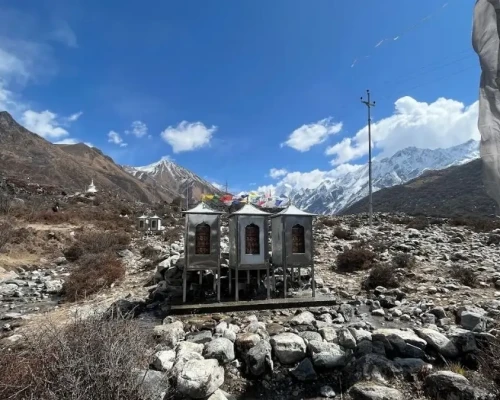
.webp)
.webp)
.webp)

 based on 5 reviews
based on 5 reviews